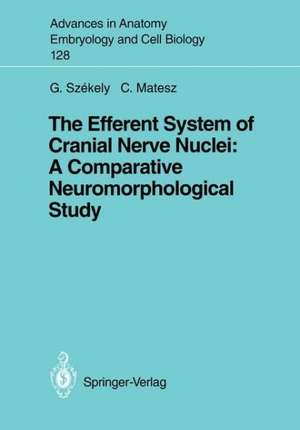The Efferent System of Cranial Nerve Nuclei: A Comparative Neuromorphological Study: Advances in Anatomy, Embryology and Cell Biology, cartea 128
Autor George Szekely, Clara Mateszen Limba Engleză Paperback – 3 mar 1993
Din seria Advances in Anatomy, Embryology and Cell Biology
- 5%
 Preț: 1146.33 lei
Preț: 1146.33 lei - 5%
 Preț: 721.19 lei
Preț: 721.19 lei - 15%
 Preț: 637.13 lei
Preț: 637.13 lei -
 Preț: 381.81 lei
Preț: 381.81 lei - 15%
 Preț: 644.95 lei
Preț: 644.95 lei - 5%
 Preț: 1025.16 lei
Preț: 1025.16 lei - 15%
 Preț: 689.97 lei
Preț: 689.97 lei - 15%
 Preț: 577.07 lei
Preț: 577.07 lei - 15%
 Preț: 580.36 lei
Preț: 580.36 lei - 5%
 Preț: 393.51 lei
Preț: 393.51 lei -
 Preț: 408.66 lei
Preț: 408.66 lei -
![Die Schlüpfdrüse der Geburtshelferkröte (Alytes o. obstetricans [LAURENTI]) und anderer Froschlurche](https://i4.books-express.ro/bs/9783662239742/die-schluepfdruese-der-geburtshelferkroete-alytes-o-obstetricans-laurenti-und-anderer-froschlurche.jpg) Preț: 408.27 lei
Preț: 408.27 lei - 5%
 Preț: 1090.61 lei
Preț: 1090.61 lei - 5%
 Preț: 705.11 lei
Preț: 705.11 lei - 5%
 Preț: 706.04 lei
Preț: 706.04 lei - 5%
 Preț: 357.61 lei
Preț: 357.61 lei - 5%
 Preț: 704.59 lei
Preț: 704.59 lei - 5%
 Preț: 705.11 lei
Preț: 705.11 lei - 5%
 Preț: 359.42 lei
Preț: 359.42 lei - 5%
 Preț: 711.52 lei
Preț: 711.52 lei - 15%
 Preț: 635.47 lei
Preț: 635.47 lei - 15%
 Preț: 631.72 lei
Preț: 631.72 lei - 15%
 Preț: 633.35 lei
Preț: 633.35 lei - 15%
 Preț: 632.37 lei
Preț: 632.37 lei - 5%
 Preț: 706.60 lei
Preț: 706.60 lei - 15%
 Preț: 631.07 lei
Preț: 631.07 lei - 5%
 Preț: 707.13 lei
Preț: 707.13 lei - 5%
 Preț: 707.33 lei
Preț: 707.33 lei - 5%
 Preț: 359.60 lei
Preț: 359.60 lei - 5%
 Preț: 707.69 lei
Preț: 707.69 lei - 5%
 Preț: 707.13 lei
Preț: 707.13 lei - 5%
 Preț: 708.06 lei
Preț: 708.06 lei - 5%
 Preț: 706.41 lei
Preț: 706.41 lei - 5%
 Preț: 708.78 lei
Preț: 708.78 lei - 5%
 Preț: 705.68 lei
Preț: 705.68 lei - 5%
 Preț: 705.11 lei
Preț: 705.11 lei - 5%
 Preț: 706.77 lei
Preț: 706.77 lei - 15%
 Preț: 635.15 lei
Preț: 635.15 lei - 15%
 Preț: 631.07 lei
Preț: 631.07 lei - 5%
 Preț: 706.77 lei
Preț: 706.77 lei - 5%
 Preț: 710.79 lei
Preț: 710.79 lei - 5%
 Preț: 705.32 lei
Preț: 705.32 lei - 15%
 Preț: 633.19 lei
Preț: 633.19 lei - 15%
 Preț: 629.09 lei
Preț: 629.09 lei - 15%
 Preț: 633.53 lei
Preț: 633.53 lei - 15%
 Preț: 632.70 lei
Preț: 632.70 lei - 15%
 Preț: 633.68 lei
Preț: 633.68 lei - 18%
 Preț: 773.72 lei
Preț: 773.72 lei - 15%
 Preț: 630.43 lei
Preț: 630.43 lei
Preț: 706.04 lei
Preț vechi: 743.20 lei
-5% Nou
Puncte Express: 1059
Preț estimativ în valută:
135.12€ • 146.72$ • 113.50£
135.12€ • 146.72$ • 113.50£
Carte tipărită la comandă
Livrare economică 22 aprilie-06 mai
Preluare comenzi: 021 569.72.76
Specificații
ISBN-13: 9783540562078
ISBN-10: 3540562079
Pagini: 104
Ilustrații: X, 92 p. 13 illus.
Dimensiuni: 170 x 242 x 5 mm
Greutate: 0.18 kg
Editura: Springer Berlin, Heidelberg
Colecția Springer
Seria Advances in Anatomy, Embryology and Cell Biology
Locul publicării:Berlin, Heidelberg, Germany
ISBN-10: 3540562079
Pagini: 104
Ilustrații: X, 92 p. 13 illus.
Dimensiuni: 170 x 242 x 5 mm
Greutate: 0.18 kg
Editura: Springer Berlin, Heidelberg
Colecția Springer
Seria Advances in Anatomy, Embryology and Cell Biology
Locul publicării:Berlin, Heidelberg, Germany
Public țintă
Professional/practitionerCuprins
1 Introduction.- 1.1 Theories Regarding the Evolution of the Head.- 1.2 The Classification of Cranial Nerves.- 1.3 Inconsistencies and Contradictions in the Classification of Cranial Nerves.- 2 Materials and Methods.- 3 The Hypoglossal Nucleus: The Appearance of the Muscular Tongue.- 3.1 Frog.- 3.2 Lizard.- 3.3 Rat.- 3.4 Conclusion.- 4 The Control of Patterned Eye Movements: The Oculomotor, Trochlear, and Abducens Nuclei.- 4.1 The Positions of the Eye Moving Nuclei and the Organization of Muscle Innervation.- 4.2 Neuronal Morphology in the Eye Moving Nuclei.- 4.3 Conclusion.- 5 The Protection of the Eye: The Accessory Abducens Nucleus.- 5.1 The Position of the Accessory Abducens Nucleus.- 5.2 The Neuronal Morphology in the Accessory Abducens Nucleus.- 5.3 The Function of the Accessorius Abducens-Retractor Bulbi System.- 5.4 Conclusion.- 6 Control of Jaw Movements and Facial Expression: The Trigeminal and Facial Nuclei.- 6.1 The Primary Mandibular Joint and Its Muscles.- 6.2 The Secondary Mandibular Joint and Its Muscles.- 6.3 The Control of Movements at the Primary Mandibular Joint: The Amphibian and Sauropsidian Trigeminal and Facial Nuclei.- 6.4 The Control of Movement at the Secondary Mandibular Joint: The Mammalian Trigeminal Nucleus.- 6.5 The Control of Facial Expression: The Mammalian Facial Nucleus.- 6.6 Conclusion.- 7 The Muscles of the Middle Ear.- 7.1 The Central Innervation of the Tensor Tympani.- 7.2 The Central Innervation of the Stapedius.- 7.3 Conclusion.- 8 Deglutition and Phonation: The Ambiguus Nucleus.- 8.1 The Innervated Periphery.- 8.2 The Structure and Cytoarchitecture of the Ambiguus Nucleus.- 8.3 Conclusion.- 9 The Control of Head Movements: The Accessory Nerve Nucleus.- 9.1 The Periphery.- 9.2 The Accessory Nerve.- 9.3 The Topography and Cytoarchitecture of the Accessory Nerve Nucleus.- 10 Neurons of the Cranial Parasympathetic Outflow.- 10.1 The Edinger-Westphal Nucleus and Ciliary Ganglion System.- 10.2 The Medullary Parasympathetic Outflow.- 10.3 Conclusion.- 11 General Conclusions.- 11.1 The Arrangement of Cranial Nerve Motor Nuclei.- 11.2 Comments on the Morphological Classification.- 11.3 Trends in the Evolution of Cranial Nerve Nuclei.- 11.4 Corollary Considerations.- 11.5 Summary.- References.



